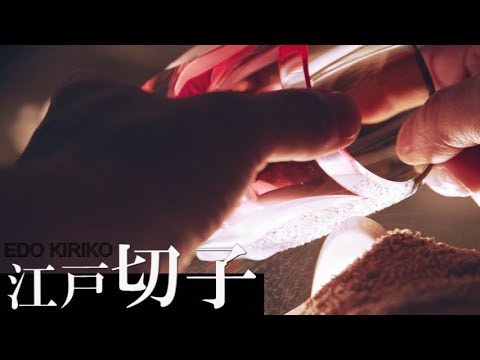今後も、『アートな感覚』をとりいれ生活を豊かにしていく発信をおこないます。
チャンネル登録をお願いいたします。~チャンネル登録はこちらから~
鍋谷グラス工芸社
1949年に創業、現在は江戸切子の伝統工芸士である鍋谷淳一で三代目になる工房です。
透明なガラスに2種類の色ガラスを被せた多色被せの江戸切子を得意としており、
美しい自然や動植物をモチーフに、大胆に表現したカットや伝統的な文様を施した、
表情豊かな江戸切子を製作しています。
【オンラインサイト】
comingsoon
【鍋谷グラス工芸社公式HP】
色ガラスに、光の通り道を刻み込む。
19世紀に生まれた江戸切子は、ヨーロッパのカットグラスの技法を取り入れた工芸品である。切子の産地は江戸以外にも薩摩(現在の鹿児島県)が知られる。時の権力者の庇護を失った薩摩切子が一時途絶えたのに対し、庶民の日用品として愛用された江戸切子は伝統を脈々と受け継ぐ。光の反射が魚卵の連なりに似ていることに由来する魚子をはじめ、二十種ほどある伝統的な文様は、少しも色褪せることなく現代の食卓に華やぎをもたらす。職人たちは伝統的な文様を受け継ぐ一方、オリジナルのカットを用いた製品づくりにも貪欲だ。厚さ2〜3ミリほどの色被せガラスを削る薩摩切子のぼかしの技に対し、江戸切子は厚さ1ミリ弱の色被せガラスに繊細な彫りを施し、その特徴であるシャープで鮮明な輝きを生み出す。上から覗き込むと万華鏡のように光が反射する切子の人気は高いが、透明ガラスに文様を施した切子のシンプルな美しさも再評価されている。日本酒、ビール、ワイン用など様々な形状が作られ、日用品としての使い勝手の良さ、長く使っても飽きのこないデザインが追求され続けている。
伝統的な技術・技法
墨付けは、竹棒の長さでガラス器の口からの位置を割り出し、内側を等分に分割した紙筒にガラス器をさし込んで水平位置の割出しをする。
荒摺り、三番掛けは、金剛砂の粒度を使いわけ、金盤の車の山は図柄によって3種類を使用する。
石掛けは、砥石車は天然産(九州の五島、笹口)の丸砥石を用いる。
研磨は木車(桐、柳)に磨き粉をつけ、図柄を丁寧に磨き上げる。
沿革と特徴
切子とは、ガラスの表面に金盤や砥石を用いて、いろいろな模様をカットする技法、つまりカットグラスのことある。
江戸切子を創始したのは大伝馬町でビードロ屋を営む加賀屋久兵衛である。
久兵衛はビードロの製造技法の先進地であった大坂で学び、その後、江戸に戻りビードロ屋を開業し眼鏡、寒暖計、比重計などを製造していった。
切子技法によるキラキラと輝く精緻な文様は、それにふさわしいガラス素材「クリスタルガラス」を得て、より真価を発揮していった。
そして大正から昭和にかけては、工芸ガラスといえばカットグラスといわれるほど、カットグラス業界は急速に、しかも高度な発展を遂げ、昭和15年頃には戦前における最盛期を迎えた。
今日、東京における切子工場は江東区と墨田区の両区に全体の八割が集中している。
なお、江戸切子と並び称される薩摩切子は、薩摩藩が江戸のビードロ業者四本亀次郎を招き、藩を挙げてガラス製造に取り組んだことから急速に発展したものである。
Edo Kiriko
(Cut Glassware)
On colored glass, a path of light is engraved.
Edo Kiriko (cut glassware), born in the 19th century, is a craft that drew from a European cut-glass technique. Another Kiriko product tradition is found in the Satsuma (currently Kagoshima Prefecture) area outside of Edo. While Satsuma Kiriko lost the patronage of those in power at that time and the tradition was temporarily suspended, Edo Kiriko maintained its popularity as everyday products having simple beauty for ordinary people and its tradition has been handed down to today’s generation. Including the Nanako pattern, which looks like a series of fish eggs in a reflected light, a range of some 20 traditional patterns inspire gaiety at the modern dining table. Craftsmen are keen to manufacture new products using original cuts in addition to inherited traditional patterns. Whereas Satsuma Kiriko uses a shading technique to cut Irokise (colored) glass 2 mm to 3 mm thick, Edo Kiriko creates sharpness and clear shininess, created by fine carving of colored glass of a little less than 1 mm thick. Kiriko is popular because it reflects the light like a kaleidoscope when seen from above and Kiriko’s simple beauty, created by designs on the transparent glass, is once again being highly acclaimed. Craftsmen are manufacturing vessels of various shapes, for sake, beer, and wine, and are exploring durable designs that are also convenient for everyday use.
History and Characteristics
Kiriko is a form of glass cutting in which grinders and whetstones are applied to the surface of glassware, and a number of different cutting (or grinding) techniques are employed in order to manufacture products.
The originator of the traditional craft of Edo Kiriko (cut glassware) was Kagaya Kyubei, who ran a glassware store in Edo’s Odenmacho (in the vicinity of modern Nihonbashi).
Kyubei is said to have learned his craft in Osaka, which at one stage was a leading center of glassware production in Japan. After completion of his apprenticeship, he returned to Edo and opened a glassware store in the city, where items such as eye glasses, thermometers and hydrometers were produced.
Edo Kiriko techniques deliver exquisite patterns that are both sparkling and lustrous when applied to suitable glassware such as “crystal glass,” such techniques delivering products of great intrinsic value.
As Japan moved from the Taisho Era to the Showa Era, manufacturing evolved so quickly that “cut glass” came to be synonymous with “artistic glass,” with the industry reaching its pre-war zenith around 1940.
In contemporary times, approximately 80% of Edo Kiriko manufacturing occurs in Koto and Sumida Wards.
Concerning Satsuma Kiriko (cut glassware produced in Kyushu), which is as equally loved as Edo Kiriko, it resulted from the Satsuma Domain (who ruled over modern Kagoshima Prefecture) inviting the Edo glassware manufacturer, Yotsumoto Kamejiro, to establish glassware production in the domain. This industry grew quickly as the government of Satsuma fully supported its development.
#TEWAZA #江戸切子 #技 #アート #インテリア


AloJapan.com